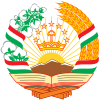List of World Heritage Sites in Tajikistan

Locations of UNESCO World Heritage Sites in Tajikistan. Blue dots indicate the Silk Roads: Zarafshan-Karakum Corridor sites.
This is a list of World Heritage Sites in Tajikistan with properties of cultural and natural heritage in Tajikistan as inscribed in UNESCO's World Heritage List or as on the country's tentative list.
World Heritage Sites[edit]
- Site; named after the World Heritage Committee's official designation
- Location; at city, regional, or provincial level and geocoordinates
- Criteria; as defined by the World Heritage Committee[1]
- Area; in hectares and acres. If available, the size of the buffer zone has been noted as well. A value of zero implies that no data has been published by UNESCO
- Year; during which the site was inscribed to the World Heritage List
- Description; brief information about the site, including reasons for qualifying as an endangered site, if applicable
| Site | Image | Location | Criteria | Year | Description |
|---|---|---|---|---|---|
| Proto-urban site of Sarazm | 
|
Sughd Region 39°30′28″N 67°27′37″E / 39.50778°N 67.46028°E |
1141; ii, iii (cultural) | 2010 | Sarazm, which means "where the land begins", is an archaeological site bearing testimony to the development of human settlements in Central Asia, from the 4th millennium BCE to the end of the 3rd millennium BCE. The ruins demonstrate the early development of proto-urbanization in this region. This centre of settlement, one of the oldest in Central Asia, is situated between a mountainous region suitable for cattle rearing by nomadic pastoralists, and a large valley conducive to the development of agriculture and irrigation by the first settled populations in the region. Sarazm also demonstrates the existence of commercial and cultural exchanges and trade relations with peoples over an extensive geographical area, extending from the steppes of Central Asia and Turkmenistan, to the Iranian plateau, the Indus valley and as far as the Indian Ocean.[2] |
| Tajik National Park (Mountains of the Pamirs) | 
|
Districts under Central Government Jurisdiction and Gorno-Badakhshan | 1252; vii, viii (natural) | 2013 | Tajikistan National Park covers more than 2.5 million hectares in the east of the country, at the centre of the so-called "Pamir Knot", a meeting point of the highest mountain ranges on the Eurasian continent. It consists of high plateaux in the east and, to the west, rugged peaks, some of them over 7,000 meters high, and features extreme seasonal variations of temperature. The longest valley glacier outside the Polar region is located among the 1,085 glaciers inventoried in the site, which also numbers 170 rivers and more than 400 lakes. Rich flora species of both the south-western and central Asian floristic regions grow in the Park which shelters nationally rare and threatened birds and mammals (Marco Polo Argali sheep, Snow Leopards and Siberian Ibex and more). Subject to frequent strong earthquakes, the Park is sparsely inhabited, and virtually unaffected by agriculture and permanent human settlements. It offers a unique opportunity for the study of plate tectonics and subduction phenomena.[3] |
| Silk Roads: Zarafshan-Karakum Corridor* | 
|
Districts under Central Government Jurisdiction and Sughd Region | 1675; ii, iii, v (cultural) | 2023 | The Zarafshan-Karakum Corridor is a key section of the Silk Roads in Central Asia that connects other corridors from all directions. Located in rugged mountains, fertile river valleys, and uninhabitable desert, the 866-kilometre corridor runs from east to west along the Zarafshan River and further southwest following the ancient caravan roads crossing the Karakum Desert to the Merv Oasis. Channelling much of the east-west exchange along the Silk Roads from the 2nd century BCE to the 16th century CE, a large quantity of goods was traded along the corridor. People travelled, settled, conquered, or were defeated here, making it a melting pot of ethnicities, cultures, religions, sciences, and technologies.[4] Ancient Panjakent is pictured. |
| Tugay forests of the Tigrovaya Balka Nature Reserve | Khatlon Region | 1685; ix (natural) | 2023 | [5] |
Tentative list[edit]
- Mausoleum of "Amir Khamza Khasti Podshoh" (1999)
- The Site of Ancient Town of Takhti-Sangin (1999)
- The Site of Ancient Town of Baitudasht IV (1999)
- Mausoleum of "Khoja Mashkhad" (1999)
- Buddhistic cloister of Ajina-Tepa (1999)
- Mausoleum of Hodja Nashron (1999)
- The Site of Ancient Town of Pyanjekent (1999)
- Mausoleum of "Mukhammad Bashoro" (1999)
- The Site of Ancient Town of Shahristan (Kahkakha) (1999)
- Fann Mountains (2006)
- Zakaznik Kusavlisay (2006)
- State reserve Dashti Djum (2006)
- Zorkul State Reserve (2006)
- Silk Roads Sites in Tajikistan (2013)
- Ancient Khuttal (2023)
See also[edit]
References[edit]
- ^ "The Criteria for Selection". UNESCO. Retrieved 10 September 2011.
- ^
 This article incorporates text from a free content work. Licensed under CC BY-SA IGO 3.0 (license statement/permission). Text taken from Proto-urban Site of Sarazm, UNESCO.
This article incorporates text from a free content work. Licensed under CC BY-SA IGO 3.0 (license statement/permission). Text taken from Proto-urban Site of Sarazm, UNESCO.
- ^
 This article incorporates text from a free content work. Licensed under CC BY-SA IGO 3.0 (license statement/permission). Text taken from Tajik National Park (Mountains of the Pamirs), UNESCO.
This article incorporates text from a free content work. Licensed under CC BY-SA IGO 3.0 (license statement/permission). Text taken from Tajik National Park (Mountains of the Pamirs), UNESCO.
- ^ "Silk Roads: Zarafshan-Karakum Corridor". UNESCO World Heritage Centre. 2023. Retrieved 2024-01-12.
- ^ "Tugay forests of the Tigrovaya Balka Nature Reserve". UNESCO World Heritage Centre. 2023. Retrieved 2024-06-09.





